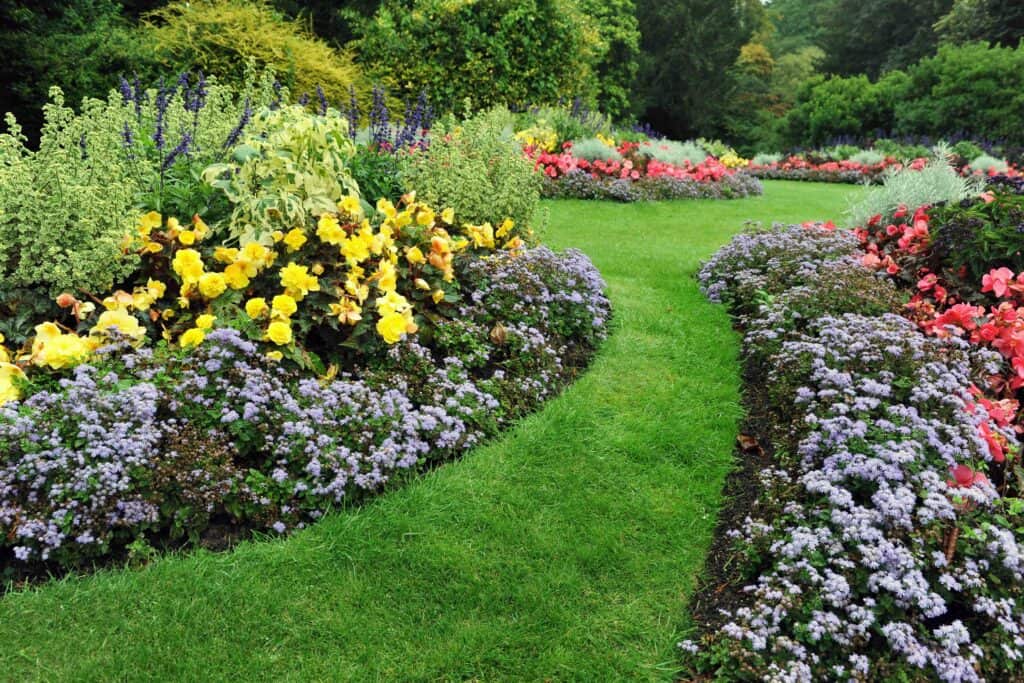There are all sorts of ways to coordinate the colors in your garden with the colors you choose for both the exterior and interior of your house. You can use colors to echo, or repeat, from house to garden, or to harmonize with one another. Or you can juxtapose colors that contrast and intensify when you place them in proximity to each other. You can approach color choices for your garden in a number of different ways. You can, for instance, design your garden so that some of its colors echo colors from your house. The colors in your garden can harmonize with the colors of the house, or the garden can contrast with the house. Either of these approaches can work if you take some time to think about your color possibilities.

There are four basic ways to work with color to build color schemes in the garden. You can rely on a single flower color contrasted against foliage, you can combine harmonious or analogous colors, or contrasting or complementary colors, or you can plant in an assortment of mixed colors.
The simplest color scheme of all is built on a single color, perhaps expressed in several different shades and tints, and perhaps with a small amount of a second color added as an accent. Monochromatic gardens can be quite soothing to the eye, and their simplicity can work extremely well in a formal setting. You might like a garden of all white flowers, or red, or yellow. Or you could combine several shades of pink.
Harmonious, or analogous, colors blend smoothly with one another. Examples of harmonious colors schemes are red, orange and gold; or blue, purple and pink. Harmonious color schemes are often quiet and subtle, such as a blend of pastel shades of pink, rose and lilac petunias. But they can also be surprisingly dramatic, as in a bed of orange and yellow cosmos and marigolds, red salvia, golden achillea and Red King Humbert canna (red flowers and purple-red leaves). An easy way to get a harmonious combination of colors is to plant several varieties of one type of flower. You might want to plant several kinds of celosia, for example, or astilbe or daylilies.
Contrasting colors are farther apart on a color wheel, and placing them next to each other emphasizes their different qualities. Complementary colors contrast more intensely than any other juxtaposition of colors. Examples include blue and orange, purple and yellow, and red and green. If you want to plant a garden of complementary colors you will probably find the most pleasing results by planting the softer of the two colors over a large portion of the garden and using the brighter color sparingly, as an accent.
In a multicolored, or polychromatic, garden, the variety of colors included depends entirely on your preference. Multicolored gardens can be blindingly brilliant if all strong colors are used; they can be cheerful and festive if you mix pastels with a few bright tones; or they can be surprisingly subtle when soft, pale colors are used. A polychromatic garden generally works best when one color is dominant to bring a sense of cohesiveness to the overall scheme. To get the best effect from a multicolored garden, surround it with lots of green to provide some visual relief. Set your flowers of many colors in front of evergreen shrubs or a hedge, or in a bed in the middle of a lawn.
However you approach the color scheme of your garden, be sure to take time to enjoy the flowers!












!['The Maples' is a prestigious generational compound of two extraordinary estates: 18 Maple and 22 Maple. This rare offering, designed by luxury architect Lissoni partners New York and developed by visionaries Alessandro Zampedri-CFF Real Estate and JK Living, redefines opulence with the highest quality of craftsmanship and captivating views of the Atlantic Ocean. Represented by @nycsilversurfer and @challahbackgirl of @douglaselliman. [link in bio]](https://hamptonsrealestateshowcase.com/wp-content/uploads/sb-instagram-feed-images/438891010_1083749139481747_7890082604579275354_nfull.jpg)
![Featuring 360-degree water views on Mecox Bay, the Atlantic Ocean and Channel Pond, 1025 Flying Point offers the ultimate beach cottage that is flooded with natural light. With panoramic views, proximity to the ocean, and a private walkway to Mecox bay for kayaking or paddle boarding, this truly is a special retreat. Represented by @ritcheyhowe.realestate and @hollyhodderhamptons of @sothebysrealty. [link in bio]](https://hamptonsrealestateshowcase.com/wp-content/uploads/sb-instagram-feed-images/438994305_737511778456166_4602476013493875279_nfull.jpg)
![Attention advertisers! 📣 Secure your spot in the highly anticipated Memorial Day edition #HRES. Reach thousands of potential clients and showcase your brand in one of the most sought-after publications in the Hamptons, NYC, Palm Beach, and beyond. Contact us now to reserve your ad space! [link in bio]](https://hamptonsrealestateshowcase.com/wp-content/uploads/sb-instagram-feed-images/438549843_275102939023235_6718257301437562124_nfull.jpg)
![You eat with your eyes, and on the East End, it’s important that what you eat looks just as good as how it tastes. At @rosies.amagansett, the restaurant itself is plenty photo-worthy with blue ceramic tiling and yellow and white striped fabric wallpaper. But for a dish that will light up your photos, head directly to the salmon tartare! [link in bio]](https://hamptonsrealestateshowcase.com/wp-content/uploads/sb-instagram-feed-images/437094269_7296727147115953_1594410326824303644_nfull.jpg)

![We were honored to be the media sponsor for @blackmountaincapital's open house event with @jameskpeyton and @jfrangeskos at 11 Dering Lane in East Hampton! Other sponsors included @landrover, Feline Vodka, @rustikcakestudio, @la_parmigiana, @lahaciendamexicangrill11968, @homesteadwindows, Stone Castle, @talobuilders, and @thecorcorangroup.
A big thank you Carrie Brudner of Black Mountain Capital for putting together this fabulous event! [link in bio]](https://hamptonsrealestateshowcase.com/wp-content/uploads/sb-instagram-feed-images/437081213_762912965932136_6847332836522786568_nfull.jpg)

![Blooms Galore at the Long Island Tulip Festival! 🌷✨ Mark your calendars for April 15th as the vibrant tulips at @waterdrinkerlongisland burst into full bloom! Enjoy a day filled with colorful splendor, food trucks, live music, and more. [link in bio]](https://hamptonsrealestateshowcase.com/wp-content/uploads/sb-instagram-feed-images/437083429_974242677583725_6855805712693638343_nfull.jpg)
